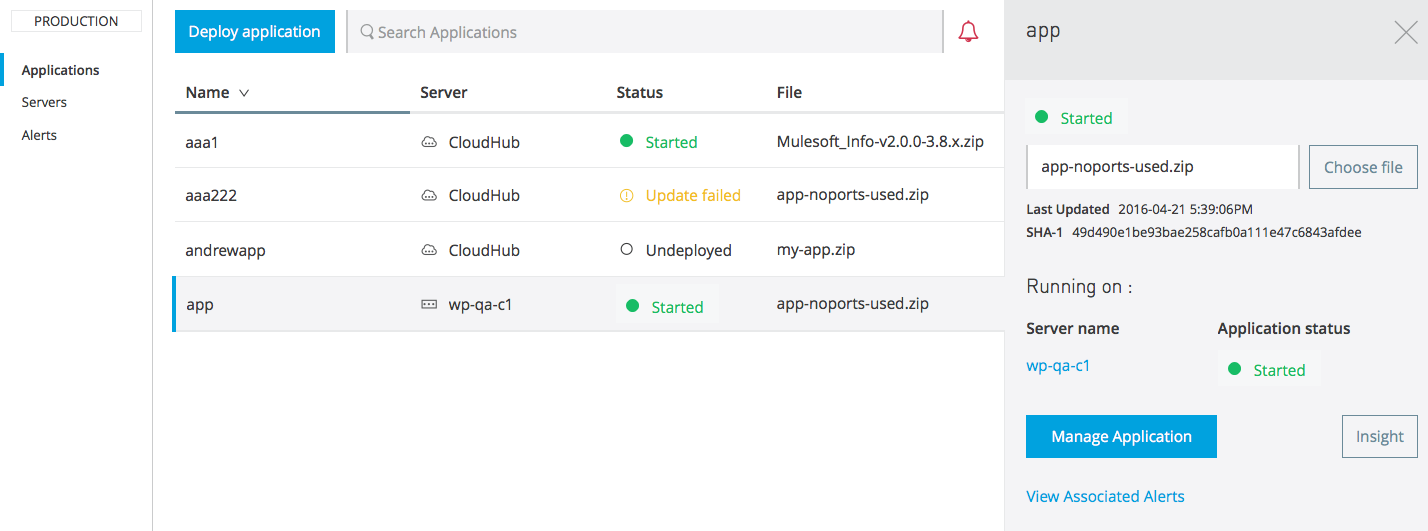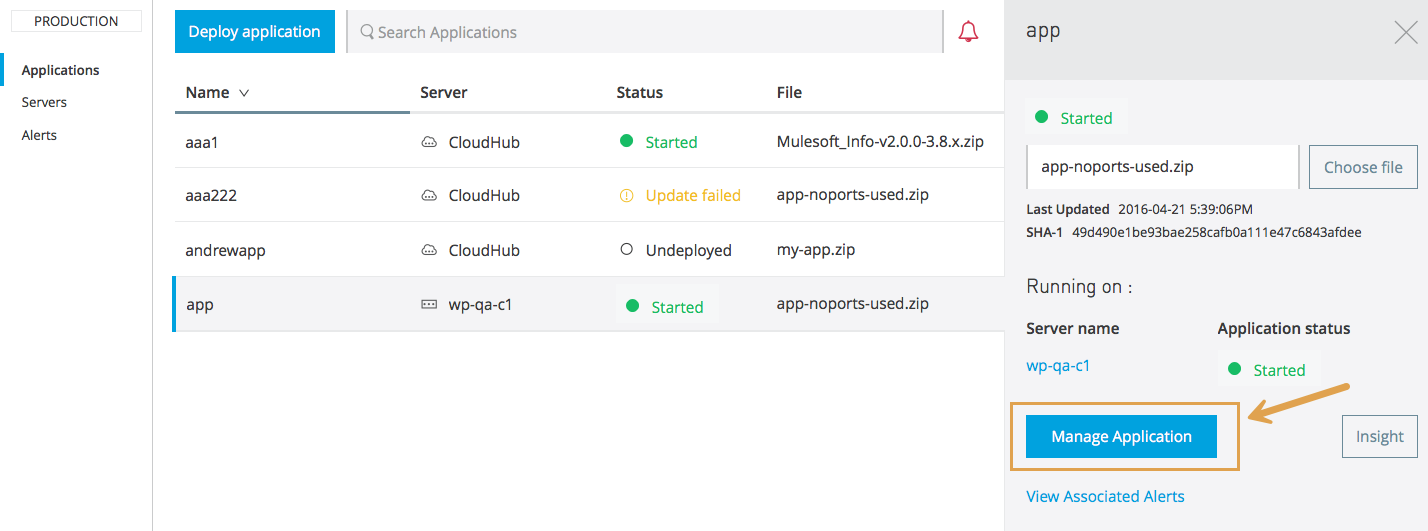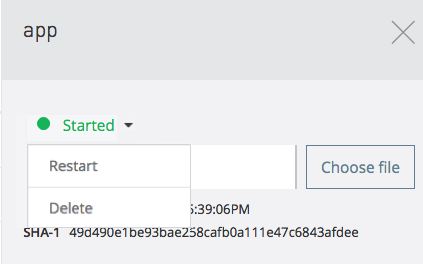
Manage Applications on Your Servers
After you add a server and deploy an application to it, you can use the Runtime Manager to monitor and manage your application.
Depending on if your application is deployed to CloudHub or to your own servers, there is a different set of possible actions you can perform on it, once deployed. This page focuses on the actions that are specific to applications deployed to your own servers. To view the basic management tools that are common to both types of deployment targets, see Manage Deployed Applications.
With applications deployed to your own servers, you can:
-
Monitor applications and the servers they run on
| This doc covers deployments on-premises that are deployed both through the cloud based or the Private Cloud Edition of the Anypoint Platform. Some of the features described in this page are not yet available on the Anypoint Platform Private Cloud Edition. See Deployment Options for a clear distinction. If you’re interested in requesting the Anypoint Platform Private Cloud Edition, please contact your sales representative. |
| MuleSoft does not support manually deploying apps if you are managing your on-premises servers with Runtime Manager. If you manually deploy applications on your on-premises servers, you can’t see or manage them in Runtime Manager because the applications are not auto-discovered. |
Applications Dashboard
If you select any of the applications on the Applications tab, a panel opens. Here you can read additional information about the application and access its settings.

What this dashboard displays depends on if your application is deployed on CloudHub or on Mule.
Applications deployed to Mule show you the status, the time of the last modification and the deployed application ZIP file – which you can change from this menu through the Choose File button. Applications deployed on clusters and server groups additionally display the list of servers and the status of each.
| You can verify info about the servers the application runs on by clicking on the server name in the panel, or by searching for it in the Servers tab. See more on Servers Dashboard. |
On all panels, two buttons are displayed:
-
The Manage Application button, which takes you to the application settings page. This page displays more detailed information about your app and the server it runs on. From here you can also access the apps dashboard, see Monitoring Dashboards for more on this.

-
The Insight button, to see data at a transaction level. See Insight for more info about what you can see here.

The Insight feature isn’t currently available on the Anypoint Platform Private Cloud Edition.
Access App Settings
Sign in to the Anypoint Platform and view the Applications tab of the Runtime Manager. Select one of your CloudHub running applications to open a panel. On that panel, click the Manage Application button to open up the application’s settings.

In this menu you can view all of the same data that’s available on the panel, with the addition of an Alerts History tab, that displays a record of the triggered alerts on this app. See Alerts on Runtime Manager for more on this.
Flow Management
You can individually start and stop the specific flows within your deployed applications via this tab in the UI. See Flow Management.
Monitor Applications
If your application is deployed to one of your own servers a set of tools exists for monitoring events that may occur on your application and the performance of the servers, server groups or clusters it’s running on. See Monitoring Applications for more details.
Delete Applications
To delete a deployed application from a server, simply click on the arrow next to its status, and select Delete.

| The server must be running for this option to be available. In the case of a Cluster or Server Group, at least one of its nodes must be running. |
Redeploying Deleted Hybrid Applications
For applications deployed on-premises, a couple of scenarios may arise which trigger specific behaviors by Runtime Manager:
-
If you manually delete an application folder or anchor file while the Mule runtime is running, the affected applications are undeployed from that local server. Applications on other nodes in a server group or cluster aren’t affected.
Only deleting from the Anypoint Runtime Manager UI or via the Runtime Manager REST API permanently removes the application. -
When Mule runtime restarts, it triggers a resync process. During the resync, Runtime Manager detects the missing applications and automatically redeploys them. This applies to single servers, server groups, and clusters.
The resync only occurs when the local Mule runtime restarts. -
When a new server is added into a Cluster or Server Group, even when no other server in that Group or Cluster is running, Runtime Manager automatically deploys any applications into that Server Group or Cluster.
Download an Application Archive
Runtime Manager doesn’t support downloading the application archive (ZIP or JAR file) from the application Settings page for an application deployed to an on-premises server. However, you can download the archive using an Runtime Manager REST Services API call or the Anypoint command-line interface.
Download CloudHub 2.0, CloudHub, and Runtime Fabric Application Archives
You can download the archive file for applications deployed to CloudHub 2.0, CloudHub, and Runtime Fabric.
-
From Anypoint Platform, select Runtime Manager.
-
Click the Applications tab.
-
Click the name of the application whose archive you want to download.
-
Click the name of the archive file in the Application File field.




